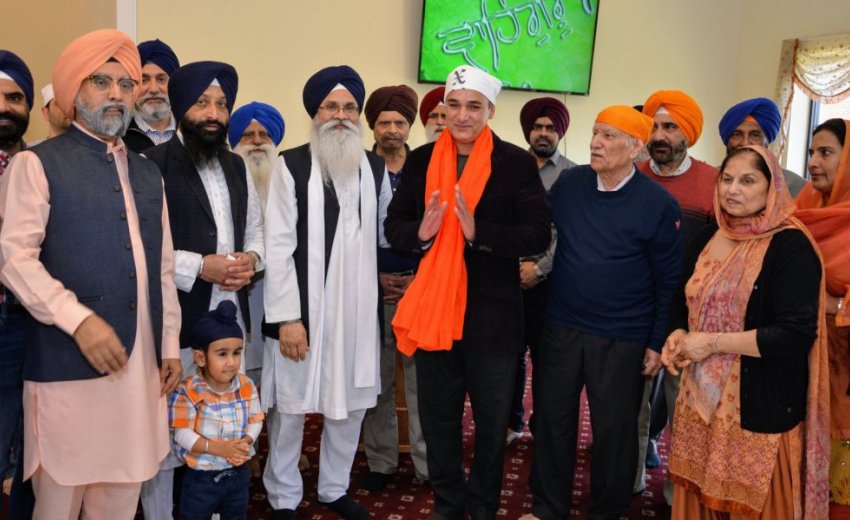Washington, March 27, 2019 : Sikh community of the Washington area honored a Pakistani Muslim activist for taking steps to preserve dilapidated buildings of Sikh Gurdwaras.
Mr Tahir Khan Kayani from the Jhelum Heritage Foundation, Pakistan, spoke at the Sikh Gurdwara Guru Gobind Singh Foundation (GGSF) in Washington and gave details of the steps he and his colleagues are taking to preserve four major Sikh sites in Jhelum. Guru Nanak had visited this area during his preaching travels called Udasis in the 15th century. These historically significant sites in Jhelum and Rohtas have remained abandoned from last 70 years since the partition.
Outside the Rohtas fort built by Shershah Suri, there is a gurdwara related to Guru Nanak and this site has a water well reportedly initiated by Guru himself which is still being used by the locals. Another Gurdwara, though in a rundown state, is Tilla Jogian which is about 3000 ft above on a hill overlooking the Jhelum and various other local areas. This is also the site in memory of Guru Nanak when he had discussions with Yogis and Sadhus (Ascetics) on various theological matters. Third important gurdwara is the birth place of Mata Sahib Kaur, wife of Guru Gobind Singh and who is considered the spiritual mother of the Khalsa. This site is within the Rohtas fort and does not have a corresponding grandeur considering the significance of this historical figure. Another grand gurdwara is Bhai Karam Singh Gurdwara, built in 30s and 40s by the local Sikh community, in memory of a Sikh who fought valiantly against the British.
Tahir Kayani and his colleagues have made plans to restore these gurdwaras and have approached the local authorities to help. Mr. Kayani said, “We have received a very positive response from everyone we approached. We also involved the Walled City of Lahore Society and they have made an initial survey to support this initiative.” Plan submitted to the government would cost 400 million rupees. He added, ”Some of these properties have been occupied by people and some abandoned and some are being used for governmental offices. Most people see the benefit of restoring these sites as they hope that Sikh community from across India and the world will start visiting these areas. We are very sure that this will help bring communities together and will generate a sense of goodwill across the two nations.”
He added, “This is the most opportune time to improve relations between India and Pakistan during Guru Nanak’s 550th birth-anniversary. It is also due to the corridor opening and we must make all efforts to strengthen the process.”
He said, “Our motivation was purely based on human concerns and we consider that these sites as our own common heritage. Even though there are no Sikhs in Jhelum, we felt that it was our moral duty to make sure that these historical gurdwaras are preserved for future generations.”
This caught the attention of the media and BBC Urdu did a major story of this local residents efforts without the initiative of the any government and this news went viral. This has generated interest of the Sikhs and in the last few months, hundreds of Sikhs have visited the area to see these gurdwaras.
Dr. Rajwant Singh, Secretary of GGSF, said, “We are very thankful to them for being so thoughtful and kind towards their Sikh brothers and sisters. This truly is a reflection of the deep seated human values among various communities across the border. This shows that common people have nothing but love for each other contrary to the common held opinion and how it is portrayed in the media.”
Sarabjit Singh Sidhu, Chairman of GGSF, said, “We would welcome an opportunity to work closely with Jhelum community to spread the word amongst all Sikhs.”
Hariraj Singh, a member of the Sikh community and former President of Baltimore Gurdwara, said, “All efforts should be made to preserve the Gurdwaras and these sites in their original beauty rather than making into a marble structure.”
Sikh community members were very happy to hear Tahir Kayani and many expressed their heartfelt thanks to him. People took turns to take picture with him.

